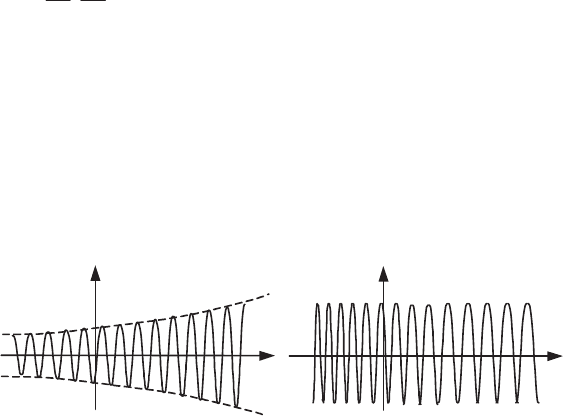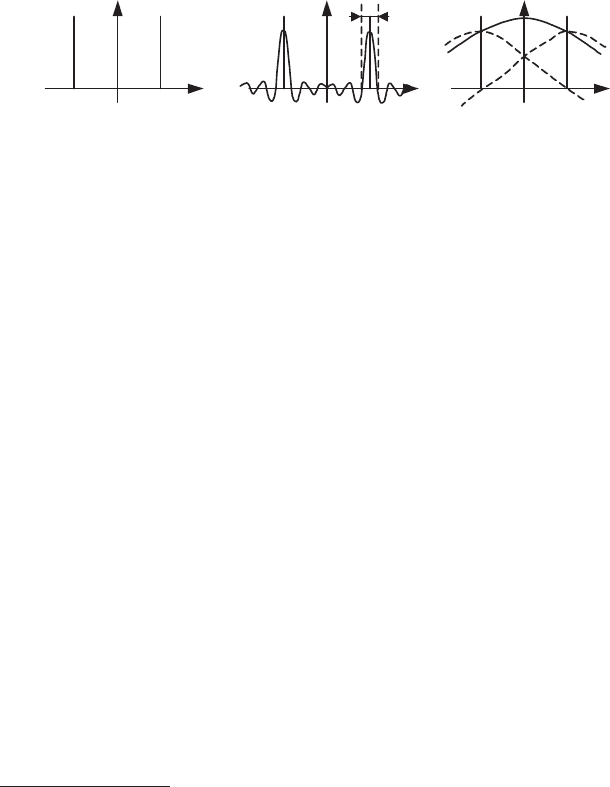Peube J-L. Fundamentals of fluid mechanics and transport phenomena
Подождите немного. Документ загружается.

Measurement, Representation and Analysis of Temporal Signals 363
distribution methods, Green’s functions, boundary element methods, etc.). These
methods often use a mathematical formalism which can be quite involved and which
we cannot cover in this text.
We will encounter this kind of methodology in the synthesis of musical sounds;
we can however already note that a musical score constitutes a combination of
elementary solutions (the notes of the instruments and indications regarding their
interpretation) which allow the representation of a musical sequence in a manner
equivalent to the numerical values recorded on a CD.
7.3.3.3.
Signal reconstruction
The reconstruction of a signal s(t) represented in the form of a series or as a
combination of functions is an intricate exercise, which can sometimes be quite
difficult. Finding a simple analytical representation of a series is an almost
impossible task, except in very specific cases; only a numerical reconstruction of the
signal is possible.
Let us recall that
a power series is associated with a function independent of the
value of its radius of convergence and it is characterized by the infinite sequence of
coefficients
. Because of this, calculating the value of a function thus represented is a
normal mathematical operation, even if the series diverges. The simplest way to
obtain the values of the developed function
s(t) is to numerically calculate the sum
of the series when possible. In the case of series divergence (or poor convergence),
there exist procedures which allow the divergence problem to be contoured or the
speed of convergence to be improved in order that its sum be efficiently calculated
(analytical prolongation, Euler algorithms, Cesaro or Féjer sums for Fourier series,
etc. The interested reader should refer to mathematical texts ([ABR 65] p. 16, [BRE
91], [PRE 07])).
In summary, a series development of a function
s(t) replaces the function by a
denumerable sequence of numerical values (series coefficients) and knowledge of
the basis functions. However, such developments are only of interest if the function
can be calculated with a small number of terms thus obtained, which is often the
case when the basis functions are solutions of the equations which correspond to the
model of the physical problem (Appendix 4).
7.3.4. Integral transforms
7.3.4.1. Introduction
An integral transform is a generalization of the idea of a series, which amounts
to developing a function on a continuous infinity of basis functions
tg ,
Q
that
depend on the parameter
Q
. Instead of obtaining a denumerable sequence of

364 Fundamentals of Fluid Mechanics and Transport Phenomena
coefficients, the result of the integral transform T of the function s(t) is the function
T
s
(
Q
) of the variable
Q
; as the information provided by the function is greater than
that contained in a denumerable sequence of coefficients, we see that the conditions
for applying integral transforms are far broader than those of series developments.
We can often associate an integral transform with a series development. The integral
transforms can comprise complex values.
An integral transform can often be inversed, in other words there exits another
integral transform
T
–1
whose result T
–1
(T (s(t))) is equal to the original function
s(t). The exact or approximate reconstruction of the initial signal is the obvious
condition for using an integral transform to store a signal. This condition is not
necessary for its analysis.
The
correlation coefficient
fg
C
of two temporal functions f(t) and g(t) is
defined by the relation:
³
!
!!
!
T
fg
dttgtf
T
gf
gf
gf
C
0
22
)()(
1
,:with
,
In the usual definition, we consider the infinite interval T by taking the limit. In
practice, this coefficient is always calculated on as large a finite interval as possible.
An integral transform is thus a factor excepted no more than the ensemble of
correlations between a function s(t) and the family of basis functions
tg ,
Q
.
An integral transform only provides interesting information and simplifications
if a large correlation is obtained for a small number of functions
tg ,
Q
. In such
cases significant interpretations may be possible. The use of an integral transform is
only of interest if a reduced set of basis functions represents a notable part of the
properties of the signal studied. There exist many integral transforms. We will give
some examples of commonly used transforms with only some of their basic
properties, chosen on account of their physical interest. The reader will find a more
exhaustive discussion in specialized books ([AND 99], [BEE 03], [DEB 06], [GUP
83], [JER 92], [WOL 79]).
7.3.4.2.
Fourier transforms
7.3.4.2.1.
Definition and properties
We will leave aside the rigorous definition and conditions for existence of the
Fourier transform. Consider a real-valued temporal signal x(t); its Fourier transform
F
x
(
Q
) is a complex function of the frequency
Q
defined by the relation:

Measurement, Representation and Analysis of Temporal Signals 365
dtetxF
tj
x
QS
Q
2
)()(
f
f
³
The real and imaginary parts of this transform F
x
(
Q
) are:
>@ >@
dtttxFdtttxF
xx
QSQQSQ
2sin)()(Im;2cos)()(Re
³³
f
f
f
f
The modulus
)(
Q
x
F and the phase
>@
)(
Q
M
x
F of F
x
(
Q
), respectively known as
the amplitude spectrum and the phase spectrum, can be written:
>@ >@>@
>@
>@
¸
¸
¹
·
¨
¨
©
§
)(Re
)(Im
)()(Im)(Re)(
22
Q
Q
QMQQQ
x
x
xxxx
F
F
ArctgFFFF
The temporal signal is reconstructed by the inverse Fourier transform:
QQ
QS
deFtx
tj
x
2
)()(
³
f
f
F
x
(
Q
) and x(t) are two different and equivalent representations of the same
quantity, respectively in frequency space and in the temporal domain.
The main properties of the Fourier transform are:
1) the property of evenness:
x(t) real Re[F
x
(
Q
)] even, Im[F
x
(
Q
)] uneven
x(t) real even F
x
(
Q
) real even
x(t) real odd F
x
(
Q
) imaginary odd
x(-t) F
x
(-
Q
) = F
x
(
Q
)*
2) a stretching of the timescale of the function x(t) which leads to a contraction
of the frequency scale for the transform F
x
(Q) and vice versa (similarity):
)(
1
)(
)()(
a
F
a
F
txatx
Q
Q
3) a translation
W
of the timescale of the function x(t) which leads to a phase
rotation equal to –2S
WQ
for the transform F
x
(Q) and vice versa:
366 Fundamentals of Fluid Mechanics and Transport Phenomena
)()(
)(
2
)(
QQ
QWS
W
tx
j
tx
FeF
4) the Dirac distribution
G
(
Q
) is defined by the relation:
1 ) (
³
f
f
dt t
G
with: 0, ( ) 0
t tv
It satisfies:
0)()( fdttft
³
f
f
G
.
We can easily show that its Fourier transform is equal to one:
1)()(
2
)(
³
f
f
dtetF
tj
t
QS
G
GQ
The Fourier transform of a Dirac distribution centered at the origin is a constant
function of the variable
Q
, equal to one on the interval [-f, +f];
5) the Dirac distribution
)(
W
G
t centered at the instant
W
verifies:
WWG
fdttft
³
f
f
)()(
From the relation of translation of the timescale, we obtain its Fourier transform:
QWSQS
WG
WGQ
jtj
t
edtetF
22
)(
)()(
f
f
³
6) the inverse Fourier transform of the Dirac distribution )( N
Q
G
in frequency
space is:
1)((
)()(
21
)(
221
)(
³
³
f
f
f
f
QQG
QQG
QS
QG
SQS
QG
deF
edeNtF
tj
tjNtj
N
7) the Fourier transform of the function
tjN
e
S
2
is then the Dirac distribution
centered on frequency +
N
)(
)2exp(
NF
tjN
QG
S

Measurement, Representation and Analysis of Temporal Signals 367
8) the Fourier transforms of the functions
t
S
N
2cos
and
t
S1
2sin
are the half-
sum and the half-difference of two Dirac distributions centered on the frequencies
+
D
and -
D
.
The function
2
M
1
S
t
A
cos
, continuous in temporal space, is thus
represented by only three numerical values A,
1
and
M
in frequency-space;
9) the Fourier transform of the product of two functions x
1
(t) and x
2
(t) is equal
to a convolution product F
x1
(
Q
)*F
x2
(
Q
) of the Fourier transforms F
x1
(
Q
) and F
x2
(
Q
), and vice versa;
10) Parseval’s theorem expresses that the energy of a signal s(t) is conserved by
the Fourier transform:
QQ
dFdttsE
ss
22
³³
f
f
f
f
We see completely different distributions of information in temporal and
frequency space: the non-zero temporal signal and the infinite duration of the cosine
function is found concentrated in four non-zero values (frequencies
r
Q
, amplitude
and phase or complex amplitude), whereas the information of the Dirac
concentrated at the time axis origin is found spread over the entire frequency
domain.
7.3.4.2.2. Interpretation of the Fourier transform
Using the Fourier transform amounts to seeking the correlation between a signal
x(t) and the harmonic signals of frequency
Q
, which can be expressed in the form
e
j
S
Q
t
. This interpretation is valuable because it can be shown that the better this
correlation, the closer the signal is to a harmonic signal. For a signal mainly
comprising harmonic discrete signals, the correlation will be high for corresponding
frequencies (spectrum of lines) and the signal will be characterized by the values of
these lines. We thus obtain a small number of numerical values in the place of the
values obtained by temporal discretization of the signal. The Fourier transform
consists of representing the functions x(t) using a basis-set of harmonic functions.
The application of the Fourier transform on a temporal signal of infinite length
poses two problems that are difficult to reconcile a priori with the idea of
irreversible time associated with the second law of thermodynamics:
– on the one hand, we can only know the transform after a very long period of
time;
– on the other hand, it assumes that the beginning of the signal is situated a long
time ago in the past.

368 Fundamentals of Fluid Mechanics and Transport Phenomena
The first inconvenience makes it difficult to follow the evolution of a
phenomenon without a long enough delay; this can be remedied by means of
observation windows of limited duration. The second difficulty is more serious, as it
implies that the signals obtained by inverse Fourier transform are not possible to
realize if they occupy the time interval [-
f
, +
f
]. Only a non-zero temporal signal
which starts from a given instant is realizable: we refer to this as a causal signal,
which defines a possible action in time.
7.3.4.3.
Laplace transform
The Laplace transform possesses properties similar to those of the Fourier
transform, and is defined by the relation:
³
f
0
)()( dttfepL
pt
f
Laplace transformation is not fundamentally different from Fourier
transformation, as it consists of taking in this Fourier transform imaginary values for
the variable in complex plane; it has the same properties, except for inverse
transformation.
This transform is of considerable interest, notably for the study of damped
systems in automatic control, the family of functions for comparison with the signal
s(t) being precisely the ensemble of aperiodic damped modes of linear invariant
systems of first order. The reader can refer to texts on the dynamics and control of
systems ([BEE 03], [DEB 06], [GUP 83], [WOL 79]). We will see in Chapter 8 the
application of the Laplace transform for the solution of linear systems with constant
coefficients (Appendix 1).
7.3.4.4.
The Hilbert transform
The objective of the Hilbert transform is to define the amplitude and the
instantaneous frequency of a movement which is close to a harmonic movement, by
with variable characteristics. We here have a generalization of the definition of the
complex exponential
ntj
e
S2
(Appendix 2). We define the Hilbert transform
tH
of the signal
tH by the relation
1
:
³
f
f
ut
du
uxVPtx
t
tH .
1
*
1
SS
[7.5]
1
The notation VP means that the integral has to be understood in terms of Cauchy principal
value; notation
*
indicates the convolution product of two functions.

Measurement, Representation and Analysis of Temporal Signals 369
The Hilbert transform of
2
Q
t
S
cos
is equal to
2
Q
t
S
sin
; in general, the effect
of the Hilbert transform is to introduce a phase lag of
2/S
in the initial harmonic
function. For any real signal
tx , we can associate the complex analytical signal
t
x
D
:
) ( ) ( t
jH
t
x
t
x
D
[7.6]
The modulus
ta and the argument
t
M
of the analytical signal
t
x
D
can be
defined as the amplitude and the instantaneous phase of the signal x (t):
>
@
tj
x
etattx
M
D
)(ReRe
The instantaneous frequency
i
Q
is defined as the derivative of the instantaneous
phase
dt
d
i
M
S
Q
.
2
1
. The idea of instantaneous frequency is only meaningful for
functions that are close to harmonic functions, in other words for relatively
narrowband signals. We will note that these signals possess two very different
timescales, one rapid timescale corresponding to a “carrier” and another much
slower scale that characterizes a modulation. Figure 7.8 shows an example of a
signal modulated in amplitude (a) or in frequency (b).
Most musical signals are characterized by a fixed frequency, which is modulated
in amplitude, and in phase. They constitute the basis for the synthesis of sounds in
musical synthesizers. We will come back to this point a little later in section 7.4.3.4.
a
x
(t)
x (t)
x (t)
(a)
(b)
tt
Figure 7.8. Signal modulated in amplitude (a) or in phase (b)
7.3.4.5.
Cepstrum
The principle of cepstrum consists of taking the logarithm of a spectral density,
and then performing an inverse transform. Ordinary products and convolution
products are respectively transformed into sums and products; a harmonic

370 Fundamentals of Fluid Mechanics and Transport Phenomena
modulation of the spectrum is transformed into a Dirac in the inverse transform.
These properties are often used for signal processing applications such as:
– the suppression of echoes in acoustic signals;
– the characterization of vibrations in rotating machinery and more particularly
in obscuring the operation of machines (for example, in looking for defects in
rotating parts which result from the wear of bearings and which leads to the
appearance of lines in the spectrum or by modulation frequencies which are difficult
to see in a simple spectrum).
We will see examples of applications of the cepstrum in Appendix 3. Depending
on the problem, different definitions of the cepstrum are used ([DES 00], [JUR 08],
[NOR 03], [WAI 90]).
7.3.4.6.
Short time Fourier transforms
The Fourier transform is defined on an infinite interval. For diverse reasons, we
can only record a signal over a limited duration, and this modifies the Fourier
transform. It is thus necessary to find a compromise between the volume of
information required and the accuracy of the results obtained. Recording a signal for
a finite duration
T
, consists of multiplying it by a non-zero function over this
interval and by zero outside of this interval. Following the usual terminology, we
will say that this function, called a gate function
3
T
(t), is a particular case
(rectangular function) of a window function. The gate function
3
T
(t) centered at the
origin can be written:
¯
®
3
7
tTTt
TtT
t
220
22 1
) (
The signal transform thus truncated is written:
F
)(*)()()( ) (
2
Q
Q
Q
Q
S
TT
F
dtet
x
t
F
t
j
T
x
3
f
f
3
3
³
x
The Fourier transform of the truncated signal
x
(
t
).
3
T
(
t
) is equal to the
convolution product of the Fourier transforms of the signal
x
(
t
) on the infinite
interval and the gate
T
(t). The Fourier transform
)(
Q
T
F
3
of this one is a cardinal
sine function:
T
T
TF
T
QS
QS
Q
sin
)(
3
Now consider the effect of recording the signal
nt
S
2cos using a gate of
duration
T
. The Fourier transform of a cosine of infinite duration is composed of

Measurement, Representation and Analysis of Temporal Signals 371
two Diracs (Figure 7.9a): the spectrum of the cosine convolved with the transform
of the gate of duration T is comprised of two cardinal
2
sinusoids centered on the
frequencies
r
n
of the two preceding Dirac distributions (Figure 7.9b). Considering
that the width of the central peak of the cardinal sinusoid is characterized by its first
zero, the widening of the Dirac function peak is equal to 2/
T
, which is, for a
window
which records 10 periods
, a widening in frequency of 0.1
n
on either side of the
frequency
n
.
+ n - n
Q
(a)
+ n- n
Q
2 /T
(b)
(c)
+ n- n
Q
F
s
3
T
Figure 7.9. Fourier transform of: (a)
cos 2 ; nt
(b)
ntt
T
S
2cos ).(
3
with
1/T << 2n; (c)
ntt
T
S
2cos ).(
3
with 1/T = 2n
We see that the shorter the window, the wider the frequency band obtained: an
insufficient observation will reduce the accuracy of the Fourier transform by
“clouding” the signal.
We note that as a recording which does not disturb the
spectrum should be applied with a window which is the inverse transform of the
Dirac distribution, in other words the unrealizable infinite width time window,
which we wanted to avoid.
According to the usual Rayleigh criterion, we consider that the frequency peaks
become unidentifiable if the first zero of the cardinal sinusoid centered at the
frequency +
n is found at the frequency –n (Figure 7.9c), i.e.:
nT 2/1
d
The perception of a frequency
n requires thus an observation horizon of duration
T greater than 1/2n: the recording duration T should include at least a half period of
the lowest visible frequency of the short-time Fourier transform. Another result of
these considerations is that we can only distinguish two frequencies
Q
and
Q
+
'
Q
if
they are separated by at least the value 1/2
T. From a physical point of view, an
insufficient recording of information can only give bad results (see formula [7.8]
and Shannon’s sampling theorem (section 7.3.6.4)). We will note that the spectrum
obtained by such a transform has not only lost the details concerning the peak; but it
also contains low frequencies that do not exist physically.
2
We obtain:
tfdtf
³
f
f
WWGW
.

372 Fundamentals of Fluid Mechanics and Transport Phenomena
The Fourier transform is thus only a correlation performed between a signal and
a family of harmonic reference signals. This observation allows a simple physical
interpretation of the widening of peaks, which results from the use of a finite
window. In effect, the correlation between two harmonic functions is zero over an
infinite time, unless their frequencies are equal. However, the same correlation will
be increased, as the window size become progressively smaller and as the
frequencies are nearer. We will leave it to the reader to verify these observations.
In reality, the widening of the Dirac spectrum by the cardinal sinusoid function
is not limited to the central peak of this function and the smaller but non-negligible
amplitudes of the lateral lobes can also lead to a net increase in the width of the
spectrum obtained. This last inconvenience is a problem, in particular for analyses
of acoustic signals on account of the sensitivity of the ear (the logarithmic decibel
scale clearly leads to a smaller scale of the amplitude variations). As the energy of
the secondary lobes is quite weak, we try to re-center it on the main lobe, even if
this means widening it slightly. This can be achieved by replacing the gate function
3
T
(t) by a window function )(t
T
)
, which leads to much smaller amplitudes of the
lateral spectrum peaks than those obtained with a rectangular window:
)(*)()()()(
2
QQQ
QS
TT
FFdtetxtF
x
tj
Tx
)
f
f
)
)
³
[7.7]
The recording of a raw signal over a limited duration therefore leads to
deformations of the Fourier transform consisting of two kinds of distributive
modification of spectral energy: the widening of the central peak and the appearance
of secondary lobes. This widening of the signal spectrum can be studied and
characterized for each window by taking the “moment of the signal energy”
dttxt
2
2
)(
³
and of its transform
QQQ
dF
x
2
2
)(
³
. General considerations ([BLA
98], [FLA 98], [HIG 93], [STR 96]) allow the demonstration of the Heisenberg-
Gabor inequality:
S
tQ''
4
1
.t
[7.8]
In this inequality 't and '
Q
are respectively the duration of the energy content of
the temporal signal and the width of the frequency band in which the energy is
contained; 't is of the order of T/2 and '
Q
is analogous to the quantity 2/T defined
above for the rectangular gate. The equality is obtained for a Gauss window, which
corresponds thus to an optimum of the preceding minimization criterion. The
limitation of the preceding principle is related to the basic uncertainty of quantum
mechanics, but the physical analogy is far from complete, the interpretation of
quantities being very different in the two domains.
